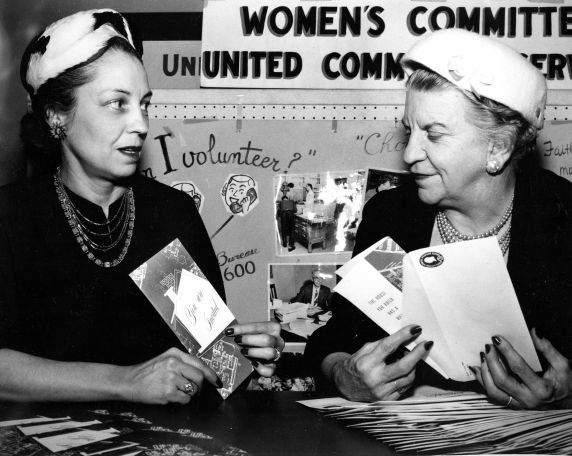The Origins and Impact of the "Women’s Mob," The United Community Services Women’s Committee
Today it is known as the fundraising branch of the United Way of Southeastern Michigan, but in 1935 it was the Detroit Community Fund and it was $150,000 in debt. Out of this crisis, the Women’s Mob was born. Looking at the lackluster state of community service funds raised by the City of Detroit, a group of women active in the Detroit Community Fund set out to fundraise enough to eliminate this debt and then to continue to build a surplus. As men had undertaken previous fundraising efforts within the Fund through professional business connections, women in the newly formed Women’s Mobilization for Human Needs leveraged their perceived roles of mothers and nurturers into a powerful fundraising entity. A passage in the February 1935 Community Fund Newsletter titled “It’s Up to the Women” states the role women were to play in remedying this financial deficit:
When you were a small boy and just had to have a dime—whom did you ask for it? Your mother. When Detroit needed kindergartens, or a juvenile court, or playgrounds—to whom did the city turn to put the job across? The women. When the Community Fund for the first time in its history writes its budgets on a deficit basis, to whom does the Board turn to educate the city as to its needs? The women.Detroit Community Fund. (February 1935). United Community Services Women’s Committee Records, Box 1 Folder 1.
Originally the group intended to educate residents of Detroit about social service agencies in their communicates and secure funding for their continued function and impact. In February of 1935 the Detroit Community Fund supported 77 social service agencies in the areas of childcare, health, family services, youth services, protection, and elderly care. Each of these agencies were tasked with forming groups of women to educate and solicit 15 financial prospects under the direction of the committees’ chairmen.
The Women’s Mob, as it was named in newspapers such as the Detroit News and Free Press, developed complex strategies to increase existing donations and gain new donors in Detroit communities. Their organization was made up of many committees, each focusing on a particular task such as group meetings, information, general publicity, radio, prospect list and speakers’ bureau among others. These committees focused on matching their message with the most receptive audiences at a particular location or event.
The information and prospect list committees gathered and communicated statistics to illustrate the impact of Detroit’s social service agencies. Some examples included site visits by members to social service agencies in order to report their latest projects and initiatives. These records include a financial prospect form that had areas to fill out potential donors estimated house value, garden appearance, and number of horses or boats among other detailed observations.
The Women’s Mob was inspired by the fundraising mobilization efforts in larger cities such as Chicago and Washington D.C. By 1960 they became known as the United Community Services Women’s Committee and had over 5,000 members. The group always emphasized the importance of women in positions of authority such as agency board members and future administrators. This collection contains important conversations that took place inside the circles of women in fundraising, social work, social service agencies, and community building. Women from the United Community Service established the Women’s Mobilization for Human Needs in Detroit in the midst of the Great Depression and this collection provides an insightful look into the role of women in the education and support of social service agencies aiding in urban community building.
For more information on the larger United Community Services organization and their departments see, United Community Services Collection, Budget Department Records, Communications Department Records, and Community Information Service Records. All United Community Service Collections can be found here.
Some interview transcripts from Philanthropy: History of Fundraising (1988) a project about the history of philanthropy and the role of women in fundraising can be found at the Indiana University Archives.
This article was contributed by Ellen Gleason, a student in Wayne State's School of Information Science in Winter 2019.


 Reddit
Reddit Facebook
Facebook LinkedIn
LinkedIn